
An ICBM loaded into the silo of the Titan Missile Museum in Tucson, AZ. Image: Aspersions
To many, the idea of inhabiting one of these spaces may sound quirky, perhaps even a little creepy. It’s certainly not something for the claustrophobic. Yet, for people unaffected by such misgivings and fascinated by military history, particularly the Cold War, living or working in a disused, underground missile silo might actually hold a certain appeal.
Titan Missile in Museum. Image: Isaac Crumm
Between the 1960s and the 1990s, while the USA and USSR remained frozen in a nuclear stand-off, subterranean missile bases proliferated like the spores of some strange, foreign fungus, technology allowing the superpowers to excavate below ground to store and deploy intercontinental ballistic missiles (ICBMs). Housed beneath the surface, the missile silos were far less likely to be detected by the sweeping eyes of satellites like the 1957-launched Sputnik, the first such orbiter to circle the earth, and protected by massive, heavy blast door ceilings, they became practically invulnerable to bombing attacks and even to nuclear strikes.
Surface view of kitchen island and fireplace. Image: Silohome via Treehugger
From the early Atlas and Soviet R-type rockets through to the Titan and Minutemen families, myriad missiles designed to carry nuclear warheads were manufactured and tested in an era fueled by fear. Yet, as the first- and second-generation missile sites became obsolete — replaced by new and improved systems — they were decommissioned and left derelict or demolished. Only in more recent years did governments consider other uses for the abandoned bases, and sell them to individuals keen to convert them into distinctive dwellings. These seven former missile silos really are a study in adaptive reuse. 7. ‘Silohome’ Atlas F Missile Base, Adirondack Mountains, NY
View of Silo Home East End with plane tied down to north. Image: Silohome
Claiming to be “the finest retrofit of a missile site accomplished to date,” the converted Atlas F missile installation in New York State’s Adirondack Mountains certainly is a unique luxury getaway — lavishly furnished but also private and secure like no other. Boasting both road access and a private airstrip, set on a 100 acres of land with forest and trails, and surrounded by beautiful panoramic scenery care of its 1,350-foot mountaintop location, this is a prime piece of real estate. But, carved into solid rock, the best bits are inside.
Original condition in 1962. Image: Silohome
As well as featuring a massive open floor plan chalet and hangar at ground level, deep inside the bowels of the complex, the onetime launch control center is now the most intriguing aspect of the ‘Silohome.’ Over two levels and 2,300 square feet, part of the missile silo’s vault has been restored and renovated — its bedrooms, bathrooms, living area and kitchen connected by a giant spiral staircase. Just think what could be done with the remaining 20,000 square feet of this cavernous space — a Bond villain’s dream.
Hallway 2,000-lb blast door in open and closed position. Image: Silohome via Treehugger
In terms of pure repurposing, this “super-hardened” vertical silo also retains some incredible traces of its history. If descending the 125-foot stairwell from the surface to the launch control center (LLC) and silo is not exciting enough, there is also an escape hatch to climb leading straight back to the upper levels of the LCC and garage above. There are even massive Star Wars-like blast doors and a large tunnel to pass through to access the silo — itself a colossal 170-foot-deep steel superstructure, suspended on giant springs, and built to withstand the impact of all but a direct nuclear hit. You’d almost be safe if Armageddon arrived.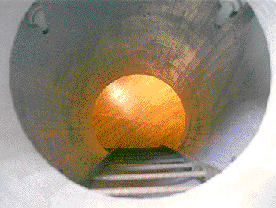
Escape hatch from garage to LCC. Image: Silohome
The real estate agents roll off various possible uses for the Silohome, among them a recording studio, which rings true given that the acoustics and sound proofing are probably second to none; it would also make a great movie location; or for the more paranoid, keen to be able to run for the hills and lock themselves underground should disaster strike, a safe home: “With the reality of September 11th, why not have a safe haven to retreat to if one needs the option,” states the website. A home marketed to all types, it seems.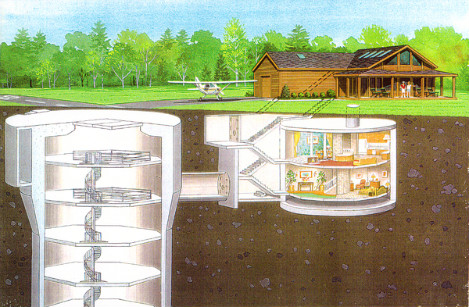
Image: Silohome via Treehugger
Finally, we’re reassured that the site is no longer a target for a flexing of foreign military might, the Atlas F nuclear missile sites having been completed before the 1970s Strategic Arms Limitation Talks, meaning the Russians were aware they had been retired and abandoned. Neither is there any danger of residual contamination, as the water surrounding the property has rigorously been tested for such a risk. Interested in making a purchase? Built for $18 million in 1958, the complex is now priced at $2.3 million, but claimed to be worth up to $100 million. It may no longer house a bomb, but it sure could cost one! 6. ‘Subterra’ Home Atlas E Missile Site, Topeka, KS “This has been the best investment of our lifetime, we love our home.” — Ed and Diana Peden
Atlas ICBM sequence images of missile erection, fueling and launch. Image: U.S. Government
The decommissioned Atlas E Missile site situated in the hills near Topeka, KS, and named “Subterra” by it current owners, is another abandoned beauty that was salvaged and given a new lease of life — as well as a more peaceful retirement package.
Ed and Diana Peden at the entrance to the tunnel and two original toilets converted into a luxury bathroom. Image: 20th Century Castles
Built in 1960 for $3.3 million, it was used until the 1970s, before being left derelict, and later reclaimed and refurbished — reborn as the protected underground home it is today.
Castle turret; an old grain silo over an escape hatch with a spiral staircase inside it. Image: 20th Century Castles
Once the silo housed an intercontinental ballistic missile with a 4-megaton warhead ready to be fired on Soviet targets at a moment’s notice; now the nuclear-tipped rocket is gone, but the Bat Cave-like structure has been left intact. The launch control center has been transformed into a spacious subterranean living space over thousands of square feet, with 15-foot-high ceilings and light flooding in through adapted skylights. The former launch service area can be reached via tunnel more than 100 feet long, and two escape hatches are still in place. The old missile bay, meanwhile, is accessible by car through an imposing 47-ton blast door.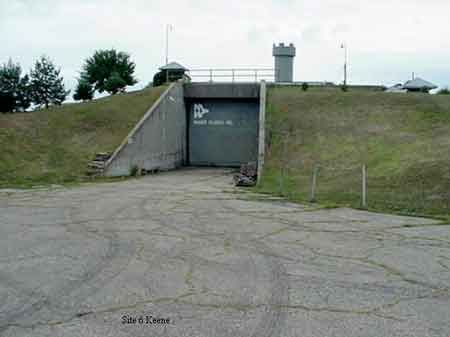
Door to the missile bay, where the actual missile was stored. Image: 20th Century Castles
Covered by 3 feet of compacted earth, this “semi-hardened” relic of the Cold War may not have been as strong in the face of nuclear attack as the deeper silo bases like the later Atlas F sites, but it could certainly handle an air strike — and today provides insulation from the heat and the cold plus protection against thunderstorms. Owners Ed and Diana Peden, who have lived underground since 1994, think of these silos as “the 20th Century’s counterpart of the fortified castles of past centuries” — and this comparison of the modern and the medieval seems fitting. Despite its forbidding, belligerent past, the atmosphere is said to be quiet and serene. 5. Jackson Heights High School (Abandoned Atlas E Missile Silo)
Picture of the tunnel entrance before renovation and the entrance tunnel at the school now brightly painted. Image: 20th Century Castles
Another abandoned missile base that found a new purpose, Jackson Heights High School was built on the site of one of the 27 Atlas E silos constructed in the early ’60s, and was one of nine in northeast Kansas before its 1964 closure. After lying forsaken, the base was bought by local school districts from the government for the bargain price of $1, and a few minor modifications later the first class bell rang in 1969. Now, says 20th Century Castles: “The missile bay has become a bus garage, the command center turned into a classroom, and teenagers from area communities replace the military officers who once patrolled the grounds.”
Air Force officers speaking at the 1961 commissioning of the missile base near Holton, KS. This base is now the site of Jackson Heights High School. The structure that held the missile is now the garage for the school’s buses. Image: United States Air Force
This piece of repurposing is clearly more community spirited than those we’ve seen so far, but it remains an extremely strong construction, its concrete walls 18 inches thick — a bunker if ever one was needed in times of crisis, and an “expansive, virtually impregnable fortresses.” Since being shut down by the U.S. military, Atlas E sites are the type most in demand for retrofit use, whether as homes or places of work. The buried “coffin launchers,” where the rockets were kept in a horizontal position prior to being erected for launch, are apparently easier to convert than Atlas F complexes in which the missiles were stored vertically. 4. Plokšciai SS-4 Missile Silo Complex, Lake Plateliai, Lithuania
Plokstine Base, living area building. Image: © Martin Trolle
Of course, far away on another continent, the USSR was busy with its own nuclear program — indeed the U.S. knew their Soviet counterparts were streaking ahead of them in the arms race. Among the missile bases built behind the Iron Curtain at the start of the 1960s was the one nestled near the village of Plokšciai, on Lake Plateliai in Lithuania — then a Soviet Republic. Situated in scenic countryside, it was a secret to all but the wiser locals — though now tourists are drawn here in droves to see this historic Cold War complex.
Plokstine Base, food storage. Image: © Martin Trolle
Bunkers and blocks of buildings in which the men lived and ate are dotted around, surrounded by forest that would surely reclaim them given half a chance. The old barracks are now an ecological education center — ironic in light of the highly toxic rocket fuel that may have claimed the life of one local man who broke in to salvage equipment and materials left here when the base was first deserted. Now, rest assured, the site is safe, and each day visitors venture eagerly down into the gloomy 90-foot missile shafts below.
Plokstine, Dvina silo complex room 7, with gas mask and other objects on display. Image: © Martin Trolle
Long after the missile base was vacated in the late ’70s, in 1996 the Žemaitija National Park turned the command post and one of the shafts into an exhibition replete with relics of the site’s former purpose, from gas masks to flasks. Tours now operate that take people through the subterranean passageways, while guides offer insight into how the base was built and occupied — a journey into the past when Soviet soldiers and officers were stationed here. You can even stand on the sealed domes of the four missile shafts. “A tourist from Germany said it felt as if he was standing on the tip of a death-bearing rocket,” writes Eugenijus Bunka.
Cupola of an underground nuclear missile silo in the Plokštine forest base. Image: Wojsyl
And, a few decades ago, he would have been. Known as SS-4 Sandals by NATO, R-12 Dvina missiles were stored in this silo, intermediate-range missile primed to be fired on target cities in Western Europe bearing their 1.3-megaton atomic warheads. These missiles may not have been as potent or possessed the range of their American opposite numbers, the Atlas Fs (1,200 miles as opposed to 6,200), but they were still fearful weapons that guaranteed it would take many years before the cold front showed any signs of warming. 3. Soviet Missile Base, Aluksne, Latvia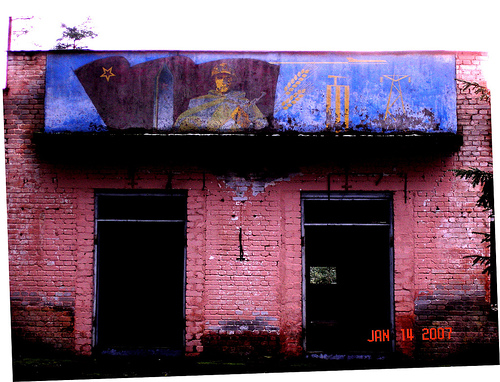
Zeltini Soviet Missile Base; mural shows the Red Flag, a missile and a soldier with a machine gun. Image: © Martin Trolle
Another former R-12 nuclear missile base open to visitors lies in Aluksne, Latvia. Less renovated than the Plokštine silo, this site is sold as a tourist attraction, with paintball among the activities offered. Where once Soviet intermediate range nuclear R-12 missile were on standby — aimed at Western Europe from 1964 until 1989 — now far safer mock military games are staged here. Dressed in camouflage gear, paintballers duck and dive between the buildings and control bunkers or run across the launch pads of a complex originally built with a far more ominous purpose in mind — though it is of course now safe to be used recreationally.
Paintballers at the Zeltinos base today. Image: Baze Zeltinos
Commenting on the current state of former Soviet missile silos, photographer Martin Trolle told us: “Most [of the] bases are just laying waste, [while] some of them are used by present-day military forces (for storage, as sports tracks or for urban warfare exercises).” And, on both sides of the Atlantic, some of these bases are now museums — destructive designs cast aside in favor of educating and enlightening people. 2. Minuteman Missile National Historic Site, Rapid City, SD
Minuteman Missile NHS, South Dakota. Image: Spencer
South Dakota’s Minuteman Missile National Historic Site differs from the sites we’ve seen so far in one glaring way: the launch facility’s missile is still present — staring up at the observer from the silo’s tube like a protruding moray eel ready to burst from a crevice in the ocean. Still, menacing as it may seem to the person on the street, the Minuteman II missile has of course been disarmed. Cue much mopping of brows.
Minuteman II missile launch. Image: United States Air Force
Originally built in the 1960s to augment America’s strategic defense force, the South Dakota site was among the first whose ICBM’s relied on solid fuel. Yet, like other second-generation missiles of its era, the Minuteman II was eventually removed following the Strategic Arms Reduction Treaty of 1991. Unlike similar such silos, however, this one was not destroyed, and the National Historic Site stands as one of the few remaining launch facility and control centers of its kind— established in 1999 to show the significance of the Cold War and its nuclear arms race, when missile envy was a syndrome suffered by both superpowers.
South Dakota Minuteman ICBM control. Image: Lars Plougmann
Made from reinforced concrete lined with steel, the complex is open to the public, who can but marvel at the vertical-lying, deactivated missile and its silo — some 80 feet deep — the original 110-ton metal cover partly opened with a glass viewing enclosure in its place. While visitors are allowed to enter the launch control center, that is as far underground as the tours are permitted; the silo itself and the rabbit warren-like complex of tunnels beneath are out of bounds on safety grounds — an impressive reminder of this beast’s latent power. 1. Titan II Missile Museum, Sahuarita, AZ
Titan II missile warhead. Image: Garydickerson
Located near Tucson, AZ, the Titan Missile Museum is another military treasure, declared a National Historic Landmark in 1994. One of the myriad nuclear missile bases built by the U.S., it is nevertheless the last surviving Titan II silo — the others having been imploded after being deactivated in 1982, when Reagan decided to modernize America’s arsenal. Now converted into an amazing museum, the original Titan II missile still stands there, a prominent reminder of a more unstable political climate.
Missile in launch duct. Image: Patrick Finnegan
Nowadays, guided tours are run through the launch control center, the vast, echoing silo, and the maze of interconnecting subterranean tunnels — all spread over 11 levels and complete with sealed, 3-ton blast locks and sci-fi-esque elevators. Built of steel-reinforced concrete, with walls up to 8 feet thick, this is surely one of the most impervious structures ever known to man. What’s more, protected from the elements by glass paneling, both the original equipment and the gargantuan missile itself remain in one piece.
Overall view of Titan II Missile control room. Image: Garydickerson
Armed with a warhead packing an earth-shattering yield of 9 megatons, the Titan II missile was the largest terrestrial nuclear missile ever employed by the U.S. Fear not, though, as the 103-foot specimen housed here has had both its active warhead and fuel removed — the latter of which would actually pose more of a risk than any radiation due to the toxic substances used to propel the rocket beyond the earth’s atmosphere.
View from the missile silo back to the control room inside the Titan Missile Museum. Image: Jeff A. Goldberg
As well as providing background information on the chilling historical context in which the Titan II missile was built, the museum has a gift shop. Restored missile engines are on display as well, and visitors can also inspect the surface areas of the complex. Finally, there is the opportunity to look out from the top level of the silo — a stirring view of the missile doors, locked half-open, and down into the innards of the launch tube itself. Hard hats are a must in view of the low-hanging parts of the structure and its adamantine make-up.
Titan missile museum silo missile door hydraulics. Image: Patrick Finnegan
In addition to serving as a museum, this incredible former missile base was also the location for several scenes from the 1996 movie Star Trek: First Contact. All in all, a must-see for Cold War nuts, or indeed anyone with a passing interest in military conflicts past or future.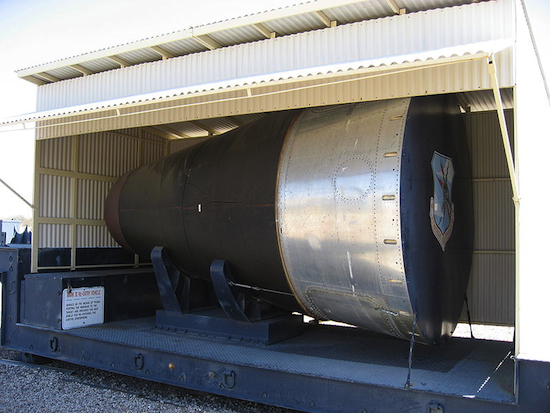
View of Titan Missile II re-entry module on display at the Titan Missile Museum. Image: Jeff A. Goldberg
Sources: 1, 2, 3, 4, 5, 6, 7